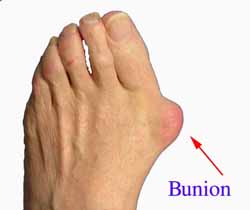 A bunion is a prominence over the inside part of the foot where the big toe joins the rest of the foot. Pressure on the prominence from shoes causes pain and swelling due to inflammation. The bunion occurs when the foot bone connecting to the big toe (the first metatarsal) moves gradually towards the opposite foot. This is called hallux valgus deformity. This leads to the big toe being pushed towards the second toe (away from the opposite foot) so that the big toe points away from the other foot. Other problems can develop with a bunion. For example the second toe may overlap the big toe causing a cross-over toe deformity. With shoe pressure, corns and calluses develop.
A bunion is a prominence over the inside part of the foot where the big toe joins the rest of the foot. Pressure on the prominence from shoes causes pain and swelling due to inflammation. The bunion occurs when the foot bone connecting to the big toe (the first metatarsal) moves gradually towards the opposite foot. This is called hallux valgus deformity. This leads to the big toe being pushed towards the second toe (away from the opposite foot) so that the big toe points away from the other foot. Other problems can develop with a bunion. For example the second toe may overlap the big toe causing a cross-over toe deformity. With shoe pressure, corns and calluses develop. Causes
Hereditary and shoe gear are probably the most likely causes. Tight pointy shoes (and high heels) may promote the formation of a bunion. A bunion may develop rapidly or develop slowly over time. Some people have bunions in their teens while others only develop a bunion later in life. Bunions come in a variety of sizes - from small to severe. In some cases, the big toe may push against the second toe, and may result in pain and a hammer toe, or progress onto a severe disfiguring foot deformity. Depending on your overall health, symptoms and severity of the bunion, the condition may be treated conservatively and/or with surgery.
Symptoms
The symptoms of a bunion include the following development of a firm bump on the outside edge of the foot, at the base of the big toe, redness, swelling, or pain at or near the MTP joint, corns or other irritations caused by the overlap of the first and second toes, restricted or painful motion of the big toe.
Diagnosis
Most patients are diagnosed to have bunions from clinical history and examination. However, in some cases, X-rays will be performed to determine the extent of damage to the joint. Furthermore, it will enable the treating doctor to decide on the best course of management of the patient.
Non Surgical Treatment
Bunions can develop at any time. Although bunions often require no medical treatment you should consult your family doctor/chiropodist/podiatrist. Treatment options vary depending on the severity of your bunion and the amount of pain it causes you. Although they don't always cause problems, bunions are permanent unless surgically corrected. If the cushioning sac of fluid (bursa) over the affected joint becomes inflamed (bursitis), a bunion can be very painful and interfere with your normal activities. Bunions may get larger and more painful, making nonsurgical treatment less effective. Apply a non-medicated bunion pad around the bony bump. If a bunion becomes inflamed or painful, apply an ice pack two to three times daily to help reduce swelling. Wear shoes with a wide and deep toe box. Avoid shoes with heels higher than 2 inches (5.1 centimeters).

Surgical Treatment
For those whose bunions cause persisting pain, a surgical operation is considered for correction of the bunion. The surgical operation to correct a bunion is referred to as a bunionectomy. Surgical procedures can correct deformity and relieve pain, leading to improved foot function. These procedures typically involve removing bony growth of the bunion while realigning the big toe joint. Surgery is often, but not always, successful; failure to relieve pain can result from the big toe moving back to its previous deviated position even after surgery. However, proper footwear and orthotics can reduce the chances of surgical failure.
Prevention
The best way to reduce your chances of developing bunions is to wear shoes that fit properly. Shoes that are too tight or have high heels can force your toes together. Bunions are rare in populations that don?t wear shoes. Make sure your shoes are the correct size and that there's enough room to move your toes freely. It's best to avoid wearing shoes with high heels or pointy toes.